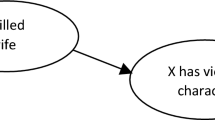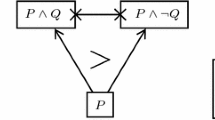Abstract
In this paper, I have two primary goals. First, I show that the causal-based story approach in A hybrid formal theory of arguments, stories and criminal evidence (or Hybrid Theory, for short) is ill suited to negative (or absence) causation. In the literature, the causal-based approach requires that hypothetical stories be causally linked to the explanandum. Many take these links to denote physical or psychological causation, or temporal precedence. However, understanding causality in those terms, as I will show, cannot capture cases of negative causation, which are of interest to the Law. In keeping with this, I also discuss some of the difficulties Hybrid Theory invites by remaining silent on the nature of the causal links. In my second aim, I sketch a way for Hybrid Theory to overcome this problem. By replacing the original, underlying causal structure with contrastive causation in the law, Hybrid Theory can represent reasoning in which the evidence that is appealed to is causally linked via negative causation to the explananda.


Similar content being viewed by others
Notes
See Bex et al. (2007).
A disadvantage of the argument-based approach is that it does not provide a complete overview of the case, as the orginal stories about “what happened: are cut into pieces to become conclusions of different arguments and counter-arguments. See Bex et al. (2007).
I will use the terms “negative causation,” “absence causation,” and “omission” interchangeably.
See Norris (2013).
See Schaffer (2004, 197).
See Bex et al. (2010, 130).
This is not a rejection of the view of causation in Section 3.3 of the (Bex 2011) paper, where it would be appropriate to make such a rejection.
Please note that, according to Sect. 2.1.2B, causal links also denote psychological causation. But there is no literature on psychological causation. Thus, I restrict my analysis to physical causation.
Bex et al., also claim that causal links also denote psychological causation. But there is no literature on pyschological causation. Thus, I restrict my analysis to physical causation and temporal precedence.
See Vitamin C Deficiency.
See Mayoclinic.
See diabetes.niddk.
See (Cáceres et al. 2000, 173).
See (Mason 2002, 4).
See (Roberts 2003, 2).
See (Hart and Honore 1985, 2–3).
Sadly, excessive causation is not the sole (or, even the main) problem with assuming that causation just means temporal precedence. Here are a few other difficulties this theory invitis. Another problem is that it involves the post hoc ergo propter fallacy, which is committed when inferring because one event occurs after another, the first event is said to be a cause of the second one. For example, in the Gregorian calendar, which has been adopted by many countries, May comes before June. But, we certainly do not think that May causes the month of June. Similarly, in the Northern Hemisphere, summer is followed by autumn. But that does not mean the former causes the latter.
As stated, we see that it is a mistake to think that summer causes autumn, on the basis that summer comes before autumn. As it turns out, both summer and autumn have the same causes—the combination of the tilt of Earth’s axis and the location of Earth in relation to the Sun. This example typifies the problem of confounding variable—a third variable Z that correlates with two other variables X and Y but is not accounted for. In such cases, Z is said to be the cause of X and Y and hence the reason the latter two correlate. Thus, assuming that causation is temporal precedence can lead to the problem of confounding variable.
Finally, one of Mill’s criteria is that cause and effect need to be correlated. That is, if there is no association, then there is no causation. This, however, has been effectively debunked (see https://probabilityandlaw.blogspot.com/2015/08/doctoring-data-review-of-must-read-book.html at the end of the article). Thus, the criterion that the cause and effect need to be correlated is not needed.
Bex et al. (2007).
For purposes of this example, suppose it is a nomic (law-like) generalization.
See Bex et al. (2007).
Ibid.
Ibid.
Ibid.
The but-for test is closely related to a counterfactual account of causation.
It should also be noted that the but-for test has limitations. It fails in cases of causal overdetermination. See Summers v. Tice.However, in cases of overdetermination, courts have ruled in order to prevent each of the defendants avoiding liability for the lack of actual cause, it is necessary to hold both of them responsible.
A possible rejoinder that a defender of Hybrid Theory might make is that HT could simply represent causal relations diagrammatically, as is shown if Fig. 1, without requiring causal language when used in the context of the law to conform to the but for test. Moreover, if there is a problem with assertions of causality, then the software would be able to make a counterargument. Allowing, however, the software to represent non-but-for-test-conforming causal assertions that will inevitably be rebutted again is unnecessary—it adds a further complication to a program that is designed to only deal with simple cases.
I do not maintain that a contrastive account of causation in the law is the only theory with the resources to overcome the problem with the current underlying structure of causation in Hybrid Theory. Indeed, other approaches such as Bayesian networks and the theory of responsibility and blame defended in Chockler and Halpern (2004) also seem equipped to handle cases of absence causation. A discussion of which approach is a better fit for Hybrid Theory, however, goes afield from the purposes of this paper.
See Schaffer (2010).
According to Schaffer, the contrastive conception of causation builds on the following work: Bas Van Frassen, The Scientific Image (1980); Peter Lipton, Contrastive Explanation, in Explanation And Its Limits, 246–266 (Dudley Knowles ed., 1990); Christopher Read Hitchcock, A Generalized Probabilistic Theory of Causal Relevance, 97 Synthese 335–364 (1993); Christopher Read Hitchcock, The Role of Contrast in Causal and Explanatory Claims, 107 Synthese 395–419 (1996); James Woodward, Making Things Happen: A Theory of Causal Explanation (2003); Cei Maslen, Causes, Contrasts, and the Nontransitivity of Causation, in Causation And Counterfactuals (John Collins, Ned Hall, & L.A. Paul eds., 2004): Jonathan Schaffer, Contrastive Causation, 114 PHIL. REV. 327–358 (2005).
See Schaffer (2010, 261).
See Schaffer (2010).
See Schaffer (2010, 273).
For a defense of this, see (Stapleton 2008, 451).
See Schaffer (2010, 278).
Following Schaffer, I will take the positive nominal “Suzy meets her dog’s basic needs s” to have the following neo-Davidsonian form \(\left( \exists e\right) \left( Agent\left( e\right) =Suzy\, \& \,Meeting\left( e\right) \, \& \,Patient\left( e\right) =Rex's\,basic\,needs\right)\). There are various places where a negation can then be inserted. But in the context of causal discourse, I take the most natural reading to be: \(\left( \exists e\right) \left( Agent\left( e\right) =Suzy\, \& \,NOT\,\left( Meeting\left( e\right) \, \& \,Patient\left( e\right) =Rex's\,basic\,needs\right) \right)\). Moreover, the existential quantifier will be contextually restricted to the salient time. So understood, “Suzy’s failure to meet her dog’s basic needs” denotes an event at the salient time in which Suzy did something that was not meeting her dog’s basic needs.
Hart and Honore (1985, 38).
Of course, this operates under the following reasonable assumption the law makes: nothing else brings about Rex’s death.
See Beckers and Vennekens (2017, 2).
This is at least an implication on many other counterfactual accounts of causation.
See Schaffer (2010, 262).
References
1-20. 14. Vitamin C Deficiency http://www.patient.co.uk/health/vitamin-c-deficiency
Aronson JL (1971) On the grammar of “cause”. Synthese 22:414–30
Beckers S, Vennekens J (2017) The transitivity and asymmetry of actual causation. Ergo 4(1):1–27
Bex F (2011) Arguments, stories and criminal evidence: a formal hybrid theory. Springer, Dordrecht
Bex F (2014) Towards an integrated theory of causal scenarios and evidential arguments. Department of Information and Computing Sciences, Utrecht University, Utrecht
Bex F, Prakken H, Verheij B (2007) Formalising argumentative story-based analysis of evidence. In: ICAIL’07, June 4-8, Palo Alto, CA USA
Bex F, van Koppen P, Prakken H, Verheij B (2010) A hybrid formal theory of arguments, stories, and criminal evidence. Artif Intell Law 18:123–152
Cáceres S, Cuellar C, Casar JC, Garrido J, Schaefer L, Kresse H, Brandan E (2000) Synthesis of protogylcans is augmented in dystrophic Mdx mouse skeletal muscle. Eur J Cell Biol 79:173–181
Castenada HN (1984) Causes causality and energy. In: French P, Uehling T Jr, Wettstein H (eds) Midwest studies in philosphy IX. University of Minnesota Press, Minneapolis, pp 17–27
Chockler, Halpern (2004) Responsibility and blame: a structural-model approach. J Artif Intell Res 22:93–115
Dowe P (1992) An empiricist defence of the causal account of explanation. Int Stud Philos Sci 6(2):123–128
Dowe P (1995) Causality and conserved quantities: a reply to salmon. Philos Sci 62(2):321–333
Dowe P (2000) Physical causation. Cambridge University Press
Ehring D (1997) Causation and persistence. Oxford University Press, Oxford
Fair D (1979) Causation and the flow of energy. Erkenntnis 14:219–50
Hart HLA, Honore T (1985) Causation in the law. The Clarendon Press, Oxford
Hitchcock C (1993) A generalized probabilistic theory of causal relevance. Synthese 97:335–364
Hitchcock C (1996) The role of contrasts in causal and explanatory claims. Synthese 107:395–419
http://www.mayoclinic.org/diseases-conditions/rickets/basics/definition/con-20027091
Hume D (2000) An enquiry concerning human understanding. Clarendon Press, Oxford (edited by Tom L. Beauchamp)
Josephson JR (2002) On the proof dynamics of inference to the best explanation. In: MacCrimmon M, Tillers P (eds) The dynamics of judicial proof—computation, logic and common sense. Physica, Berlin, pp 287–306
Kistler M (1998) Reducing causality to transmission. Erkenntnis 48:1–24
Kistler M (2001) Causation as transference and responsibility. In: Spohn W, Ledwig M, Siebelt F (eds) Current issues in causation. Mentis, Paderborn, pp 115–33
Lipton P (1990) Contrastive explanation. Roy Inst Philos Suppl 27:247–266
Mackie JL (1974) The cement of the universe. Oxford University Press, Oxford
Maslen C (2004) Causes, contrasts, and the nontransitivity of causation. In: Collins J, Hall N, Pau LA (eds) Causation and counterfactuals. MIT Press, Cambridge
Mason A (2002) Introduction to solid state physics. http://www.engr.uk.edu/~ee562/562H01-physics.PDF. Accessed 12 Oct 2002
Norris M (2013) http://www.myfoxdfw.com/story/23139596/dallas-woman-jailed-after-malnourished-dog-found-dead-in-garage
Palsgraf v. Long Island Railroad Co. (1928) 248 N.Y. 339, 162 N.E. 99
Pearl J, Russell S (2000) Bayesian networks. In: Arbib MA (ed) Handbook of brain theory and neural networks. MIT Press, Cambridge, pp 157–160 2003
Pennington N, Hastie R (1993) The story model for juror decision making. In: Hastie R (ed) Inside the juror, the psychology of juror decision making. Cambridge University Press, Cambridge
Roberts C (2003) Biological behavior? hormones, psychology, and sex. NWSA J 12(3):1–20
Russell B (1948) Human knowledge: its scope and limits. Simon and Schuster, New York
Salmon W (1984) Scientific explanation and the causal structure of the world. Princeton University Press, Princeton
Salmon WC (1994) Causality without counterfactuals. Philos Sci 61(2):297–312
Salmon WC (1998) Causality and explanation. Oxford University Press
Schaffer J (2004) Causes need not be physically connected to their effects. In: Hitchcock C (ed) Contemporary debates in philosophy of science. Blackwell Publishing Ltd., Malden
Schaffer J (2005) Contrastive causation. Philos Rev 114:327–358
Schaffer J (2010) Contrastive causation in the law. Legal Theory 16(4):259–297
Stapleton J (2008) Choosing what we mean by “causation” in the law. Mo Law Rev 73(2):433–480
Thagard P (2004) Causal inference in legal decision making: explanatory coherence vs. Bayesian networks. Appl Artif Intell 18:231–249
Thagard P (2005) Mind: introduction to cognitive science, 2nd edn. MIT Press, Cambridge, MA
Van Fraassen B (1980) The scientific image. Oxford University Press, Oxford
Woodward J (2003) Making things happen: a theory of causal explanation. Oxford University Press, Oxford
Author information
Authors and Affiliations
Corresponding author
Additional information
Publisher's Note
Springer Nature remains neutral with regard to jurisdictional claims in published maps and institutional affiliations.
Rights and permissions
About this article
Cite this article
Barclay, C.A. Is hybrid formal theory of arguments, stories and criminal evidence well suited for negative causation?. Artif Intell Law 28, 361–384 (2020). https://doi.org/10.1007/s10506-019-09258-9
Published:
Issue Date:
DOI: https://doi.org/10.1007/s10506-019-09258-9




